 Pirates and Privateers Pirates and Privateers
The History of Maritime
Piracy
Cindy Vallar, Editor
& Reviewer
P.O. Box 425,
Keller, TX 76244-0425
    
Books for Pirate Apprentices ~
Activities, Crafts, Games, & Puzzles
Escape Game Pirates
by Eric
Nieudan
illustrated
by Margot Briquet
Schiffer
Kids, 2020, ISBN
978-0-7643-6008-4, US $16.99
You awake to find yourself all alone
on a ship in the middle of the sea.
You have no memory of what happened.
Where is the captain? What became of
your mates?
That is the premise of this
combination adventure, mystery,
puzzle book. Written for pirate
apprentices between the ages of
eight and twelve, it’s up to you to
unravel clues, decipher secret
messages, and wend your way through
the ship to gather the information
you need to answer those questions.
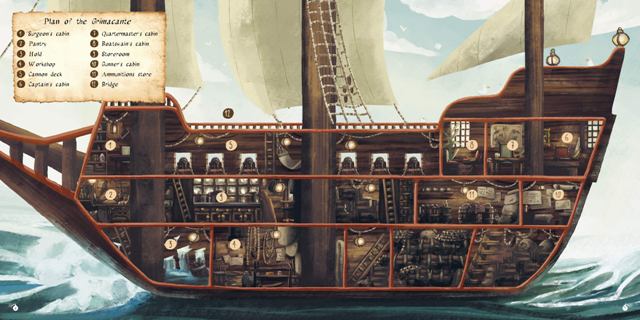
Sample page
(Source: Publisher, used with
permission, image copyrighted)
This book actually consists of two
volumes, one bound inside the other.
The main book contains the puzzles
and pictures, as well as several
pages of answers, while the clue
book contains objects and
information needed during the course
of this adventure. The main book
also contains several pages for
note-taking and list-making.
While the idea for this book is
tantalizing, the translation doesn’t
always work. According to the
instructions at the beginning of the
book, you are alone on the ship.
This is a fallacy, because others
are aboard. The fact that one may be
a traitor is downplayed, rather than
emphasized, which makes me wonder
why this is important to the story.
Check marks throughout the book are
supposed to alert readers that these
objects are important, but I only
found one such marking and by the
time I did, I forgot what the
purpose of the check mark was. The
page numbers are so small that they
are difficult to read. Although the
artwork is great and fits the mood
of the story, the subdued coloring
makes it difficult to find essential
items. For example, the trap doors
at the end of one maze are barely
visible. Another problem is that
some numbers hidden in the page
illustrations are brown on brown or
black on black, which makes them
difficult or impossible to locate.
(If you’re wondering, I have 20/20
vision and am sitting directly under
a bright light and still haven’t
found one or two of the numbers.)
Assumptions are also made that
readers will know what a particular
item is, such as in the pantry where
the food and other items are strewn
about, or that they understand
foreign words, for one puzzle uses a
French number rather than its
English equivalent. A few clues are
so cryptic or lacking sufficient
detail, I can’t solve them and there
is at least one place where the
stated solution on the answer pages
can’t possibly be correct because
the number of letters in the clue
and the answer don’t match.
If children enjoy this book, they
may be disappointed that its format
really only allows them to solve the
mystery once. Another format, such
as a spiral-bound or loose-leaf book
with laminated pages, may have
allowed them to erase their answers
and solve the mystery again and
again. Another reason the format is
an issue is that some text and
illustrations on the double-page
spreads are lost in the book’s
binding. For example, where one maze
crosses the center between one page
and the next, there’s no way to tell
if the path through the maze is open
or blocked.
One final caution to consider is how
adept pirate apprentices are at
unraveling puzzles. If they are
easily frustrated or have short
attention spans, this book may not
be a treasure they will enjoy.
Akin to role-playing games, for
which the author is a specialist,
this book requires readers to
explore, investigate, and maneuver
not only the ship and the sea but
also the intricate details of the
illustrations. A sharp mind and
excellent eyesight are essential,
and while the instructions don’t
mention the need for a magnifying
glass and good lighting, some pirate
apprentices may find these as
essential as the compass and other
tools found on a ship.
Despite these issues, I enjoyed the
majority of the book. The puzzles
and mazes are fun and somewhat
challenging. It is a book that most
pirate apprentices will not complete
in a single sitting, which is why
those blank pages are a good
inclusion so you don’t forget what
you’ve found once you’re able to
return to the mystery. Full-fledged
adult pirates who like puzzles will
also find challenges and have fun
deciphering and unraveling these.
Review
Copyright ©2020 Cindy Vallar

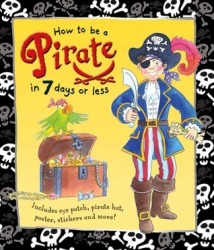 How to Be a
Pirate in 7 Days or Less
How to Be a
Pirate in 7 Days or Less
by Lesley Rees
illustrated by Jan Lewis
Kingfisher, 2006, ISBN 0-7534-6041-6,
US $12.95
Ever want to be a
pirate? Captain Kidd needs a crew,
but he must find them in just seven
days, for that’s when he sets sail
in search of treasure. At present,
he only has a first mate named
Barnacle Bill and Poopdeck, the
parrot. This seven-day crash course
in becoming a pirate will allow you
to join him on his treasure-hunting
expedition.
Day 1: Any good
pirate requires a name. Once
you’ve chosen yours, Captain Kidd
shows you how to make a porthole
nameplate to hang on your door.
Day 2: What’s a pirate without the
proper set of clothes? The
finishing touch to your costume
will be to make a cutthroat
cutlass.
Day 3: To navigate your ship, you
need a telescope to see where
you’re headed.
Day 4: What’s a pirate without a
treasure chest? When the day’s
done, you’ll have one in which to
hide your booty.
Day 5: To gather treasure, you’ll
need other pirates, so it’s time
to invite them to the party. Your
ship is in need of a Jolly Roger
to warn others that you’re pirates
in search of treasure. Once you
have that, you need a map to show
where you hide your plunder.
Day 6: Pirating is hard work, so
you’ll need lots of food, like
scurvy-busting grog, hard tack,
topsail sandwiches, doubloons,
rats’ tails & pieces of eight,
and cannonballs.
Day 7: Once your crew assembles,
there are games to play, treasure
to find, and rules to bind you
together as shipmates.
Each day,
children learn a fact or two about
pirates and make something that’s
fun and educational at the same
time. The materials needed for the
activities can usually be found at
home or purchased from a store for
little money. Inside the front cover
is a ruler for measuring and a
cutlass and skulls and crossbones to
trace. The inside back cover has a
traceable alphabet. There, you’ll
also find a “locked” satchel that
contains a hat and eye patch,
stickers, game counters and “gold”
earring, and a poster to color and
display. The book also has strings
that allow you to tie it shut.
How to be a Pirate in 7 Days or
Less is a fun and safe way to
explore the world of pirates. The
instructions are easy to understand,
although younger children will
require the aid of an adult for some
activities. (The book is geared
toward ages five to eight.) The
illustrations invite readers to
explore the pages and understand
what the day will bring. Pirates who
dare to venture within will find
plenty of treasure!
Review
Copyright ©2007 Cindy Vallar

 Lost
Treasures of the Pirates of the
Caribbean
Lost
Treasures of the Pirates of the
Caribbean
by James A. Owen & Jeremy Owen
Simon & Schuster Books for
Young Readers, 2007, ISBN
978-1-4169-3960-3, US $16.99 / CAN
$19.99
Pirates
don’t bury their treasure and
create maps that show where they
hide it. Or do they? That’s the
premise behind this book for
children ages eight to twelve,
or those who are older and like
mysteries to solve.
In 1667, buccaneer Henry Morgan
enlists the aid of Elijah McGee,
who “excelled at making detail
maps” and is a trustworthy soul.
After his grandson’s death, the
maps disappear and rumors
circulate that this dynasty of
mapmakers places hidden clues in
their maps to a secret map of
buried treasure. After many
years, the authors acquire the
maps at an estate sale. They
recreate the maps within this
book and provide, along with
historical tidbits on pirate
history, the clues and riddle
needed to discover the location
of the pirates’ treasure.
Contradictions in facts: the
authors say the earliest pirates
are the corsairs of the Barbary
Coast, who begin preying in the
1500s. On the next page they say
piracy has existed since man
first begins sailing the sea.
The latter is true, rather than
the former. Blackbeard weaves
slow matches, rather than
gunpowder, into his braids. The
smoke creates a devilish
illusion; the gunpowder will
have exploded when lit.
The presentation of material
makes readers wonder if what the
authors reveal is really true.
The idea is plausible, and the
intertwining of historical facts
with the story will have young
pirates dreaming of untold
treasure. I particularly enjoy
the Owens’ revelation about
Captain Johnson, and just the
idea of “the Pyratlas” will make
pirate-lovers salivate. The
detailed maps are gems in
themselves. While I easily
figured out the riddle, finding
the location of the treasure is
something I stumbled on to,
rather than solved.
Lost Treasures of the Pirates
of the Caribbean is a
fascinating exploration of
piratical history and maps. It
captivates the reader and makes
him/her wonder about “what if.”
While young pirates are having
fun, they’re learning, too. Once
they have the answer in hand,
they can go to the book’s
website to see if they’re right
and to download additional
pirate lore.
Review Copyright
©2007 Cindy Vallar
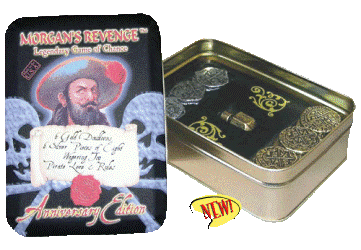 
 Morgan's
Revenge, 2006, US $15
Morgan's
Revenge, 2006, US $15
Rhumb Line, 2005, US $10
Thaxx, 2004, US $20
Channel Craft
On our excursion to
PyrateCon 2007 in New Orleans, my
husband and I took three pirate
games** with us. Each has a basis in
history and a nautical theme. All
are easily transportable and take up
little space. After we played all
three, we rated them according to
which we like best and have the most
fun playing. These games are
available through Amazon or directly
from Channel Craft.
Morgan's Revenge: Sir Henry
Morgan, the most daring and
successful buccaneer, sacks the city
of Panama and protects Jamaica from
a Spanish invasion. He seeks revenge
against those foolish enough to
cross his path. Morgan’s Revenge
is a game of chance that includes
six gold doubloons, six silver
pieces of eight, and a six-sided
pewter top. The coins are authentic
replicas from the treasure ship Atocha,
while the top’s origins date back to
the days of the Egyptian pharaohs.
The pieces come in an anniversary
tin.
There is no limit to the number of
players for this legendary game of
chance, and it’s one of the few
games where the youngest player gets
to go first and names the wager for
the round. Players take turns
spinning the top. Once it stops, the
player either takes coins from the
pot or puts them in. Sometimes,
everyone must add to the kitty.
Other times, the spinner gets to
take all the coins in the pot and
thus wins the round.
The one question we don’t find an
answer to is how many coins does
each player begin with, and we
wonder whether you can purchase
additional coins to make the game
last longer. There are only a few
rules, and you’re welcome to invent
new ones for a more challenging
game. It takes practice to get the
top to spin, but when it does, it
can spin for a long time. Morgan’s
Revenge is a clever game
that’s easy to play and lots of fun.
Rhumb Line: The rhumb line is
the shortest distance between two
compass points that cross the
meridian at the same angle. The
compass rose names the four seasonal
winds and is used by mariners after
1350. A game based on these two
nautical devices eventually evolves,
but whereas in the past it is played
on old sailcloth, the current game
is played on a rubber mat* similar
in design to a mouse pad. The
playing pieces come in a resealable
plastic bag, and a small canvas
drawstring tote is provided for
storage of the board and stones.
Designed
for two players, each receives
sixteen stones to use in play and
one for keeping score. The object of
the game is to get four stones in a
row – in a radius, an arc, or a
spiral – to score points and prevent
your opponent from scoring. The game
ends when all thirty-two stones have
been placed on the compass rose. The
player with the highest score wins.
Rhumb Line sounds
intimidating, especially for those
who aren’t keen on geometry and math
(like me), but the game is really a
sophisticated version of tic-tac-toe
and far simpler to play than either
of us expected. The challenge is to
achieve high-scoring goals without
being blocked. The more often you
play, the more adept you become at
strategizing your moves. We
particularly like the fact that we
don’t have to keep score with pencil
and paper because the game board
includes a way to track points with
just a stone. Rhumb
Line does
require players to pay attention,
and the more you play, the more you
enjoy this game. It’s fairly quick
to play, but you may want to put a
time limit on how long a player can
strategize before making a move.
*One suggestion: You
may want to air out the board for
a while before playing because it
does smell rubbery.
Thaxx:
El Cazador disappears at sea
on a dark winter’s night in 1784. On
board is a treasure of 450,000
silver reales. Legend says
that a hex, known as Thaxx, befalls
the ship. The object of this game is
to beat the odds and keep your
treasure, otherwise you become a
victim of Thaxx – just like El
Cazador, King Carlos III,
Napoleon Bonaparte, and Thomas
Jefferson.
Designed for two players (ages
seven-adult), the game consists of a
wooden playing board, two dice, and
thirty replicas from the ship’s
treasure. The board contains a large
diamond divided into two sections
with rows of numbers from one to
five. The object of the game is for
each player to fill his side of the
diamond with coins before his
opponent. The number and combination
of coins depends on the roll of the
dice. The challenge comes from the
fact that your opponent can take
coins from your side of the board to
fill his side.
I confess I’m still a bit puzzled
about the hex. Since there are no
sixes on the board, and some rolls
of the dice are meaningless. We’re
not certain whether it was the table
we played on or the dice, but the
dice tend to bounce long distances.
After playing for a while, Tom and I
decided that this is similar to
Parchessi. Since there is no
container to keep the game together,
the dice and coins may get lost. I
thought the game is less fun than
the others and slower, but Tom likes
it better than Morgan’s Revenge.
**These games are not
for small children. All have pieces
that are easily swallowed.
Review
Copyright ©2007 Cindy Vallar
 Pirate
Things to Make and Do
Pirate
Things to Make and Do
by Rebecca Gilpin
illustrated by Erica Harrison and
others
EDC Publishing, 2005, ISBN
978079451061-9, US $6.99
This craft book invites
youngsters to try their hands at
making various objects related to
the world of pirates. The activities
include making hats, coins, money
bags, telescopes, earrings, eye
patches, door signs, flags,
collages, rats, finger puppets,
treasure chests, cutlass and hook,
and cards. One can learn to draw and
paint ships, illustrate a man
overboard, paint a parrot, or design
Jolly Roger paper. Two pages of gold
stickers are included for use with
the projects.
There are a number of pirate craft
books to be found in libraries, but
this one does include some
activities rarely found elsewhere.
My favorite is the finger puppets,
which are bigger than most
commercial ones. This isn’t a book
for the youngest of pirates and, for
the most part, some artistic ability
is required. The lack of patterns,
the elaborateness of some of the
drawings, and the difficulty in
interpreting some instructions may
frustrate young pirates who don’t
have adult pirates to help. Another
drawback is the absence of a list of
items needed to accomplish each
activity. Despite these drawbacks,
this book includes unique items that
make this worth adding to a
collection where arts and crafts are
popular.
Review
Copyright ©2007 Cindy Vallar
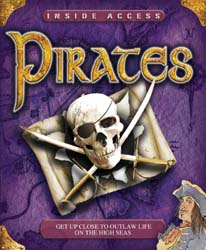
Pirates
by Philip Steele
Kingfisher, 2007, ISBN
978-0-7534-6061-0, US $9.95
Jake “Rattlebones”
Rogers swings in to guide you
through the finer points of being a
pirate. He explains why honest
sailors go on the account, explores
the history of piracy, introduces a
few of the more notorious pirates,
and talks about the vessels they
use, their weaponry, and how they
acquire booty. He also touches upon
what happens to captured pirates. A
glossary and index are included.
Part of the Inside Access series, Pirates
is written for young pirates of
five to eight years. It has large
type and color pictures to captivate
these apprentices. There are flaps
to open, maps to unfold, flags to
learn, and parts of the ship to
memorize. This worthy introduction
to piracy, particularly in the
Caribbean, teaches that it isn’t all
fun and games. The photographs,
mixed with colorful sketches, bring
this world and the past to life for
young readers.
Review
Copyright ©2007 Cindy Vallar
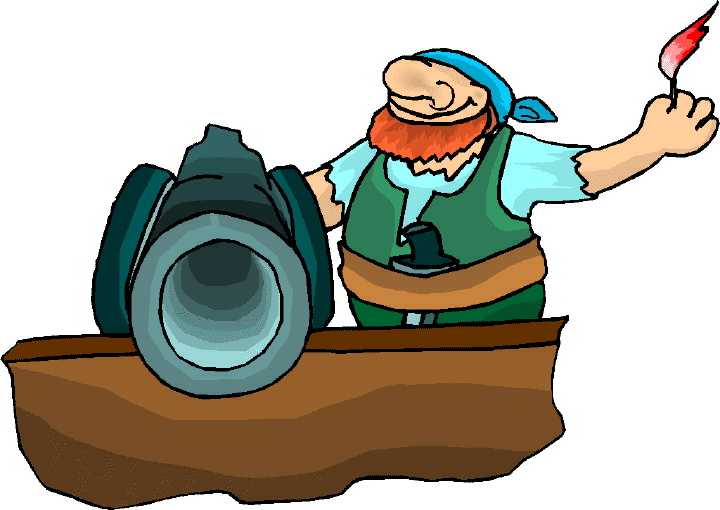
Click to contact me
Background image compliments
of Anke's Graphics |

